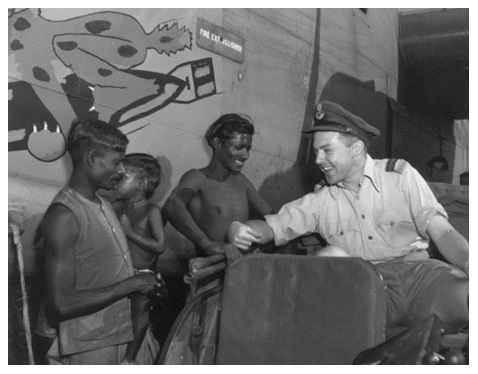
This 31” by 31” replica nose art painting was completed by the author on original B-25 WWII U.S. Navy aircraft skin, the green paint is original American wartime color. This is from a special private collection of Mr. Nose Art, Clarence Simonsen, and at age 76 years, the artist has decided to give his little nude “Petty Girl” a new home. She is for sale, but must have a good setting, and please keep her warm. This was painted in honour of the aircrew of “The Vulgar Virgin.” The November 1941, Esquire gatefold pin-up [below] is also included.
Clarence Simonsen
Contact form
Research by Clarence Simonsen
The Vulgar Virgin (PDF document)
Text version (with all images in the PDF document)
The Vulgar Virgin

This attractive lady appeared as the November 1941 gatefold issue of Esquire magazine, painted by the most famous illustrative pin-up artist in America, George Brown Petty IV. In his “Petty Girl” George created an American female icon, a full-figured beauty, all-color with a sensual look combining sophisticated sexuality with the American girl-next-door smile and sweetness. The Petty Esquire pin-up established the first fold-out [gatefold] for all future pin-up magazines, such as Playboy. These gatefolds reached new heights in popularity during World War Two, and became a major world wide aircraft nose art subject. First born, daughter Marjorie ‘Jule’ Petty [21 September 1919] became his family model plus the real living “Petty Girl” posing fully nude [1930-1948] for each and every original sketch and airbrush painting.

The Esquire cartoon nude, April 1935, was turning into the “Petty Girl” pin-up of 1937.

The American B-24 aircraft which the Petty Girl ‘Vulgar Virgin’ appeared on was one of 18,482 Liberators constructed between 1939 and 1945, designated as they were built at five American factories. The Consolidated Vultee Model 32 Liberator prototype first flew on 29 December 1939, and was put into production in September 1940, for the British, [164 bombers] and French [120 bombers] governments. When France fell to Nazi Germany, their production order was taken over by the British and Canadian government orders. The B-24 progressed through several changes under British contracts before it went into large scale production for the U.S. Army Air Corps. When a change was made at a production factory that did not require a new model designation, the change appeared in the aircraft “block number.” The factories assigned block numbers in multiples of five, B-24D-20-CO, with an Air Corps Serial 41-24198. The last two letters identified the factory where each aircraft was built, [CO] Consolidated, San Diego, and [CF] Consolidated Fort Worth, [DT] Douglas, Tulsa, [NT] North American, Dallas, and [FO] Ford, Willow Run.

When the final aircraft production was withdrawn on 31 May 1945, the two Consolidated Vultee plants at San Diego and Fort Worth had produced over 10,000 B-24 Liberators. Between 1940 – 1942 these two plants manufactured 2,728 B-24D models including “The Vulgar Virgin.”

Image from Reid Stewart Austin collection 1996
The Consolidated, San Diego, California plant constructed one-hundred and eight B-24D-20 models in four different batches during June 1942.
Batch #1 – Thirty-nine aircraft serial numbers 41-24100 – 41-24138
Batch #2 – Sixteen aircraft serial numbers 41-24142 – 4-24157
Batch #3 – Eight aircraft serial numbers 41-24164 – 4124171
Batch #4 – Forty-five aircraft serial numbers 41-24175 – 41-24219
The factory block numbers for “The Vulgar Virgin” clearly appear in the above 1943 photo.
U.S. ARMY B-24D
AIR CORP. SERIAL NO. 41-24198

In the spring of 1942, American Air Force planners had agreed to schedule nine combat groups for the Middle East and North Africa campaigns, beginning in September. This was planned to allow the American Eighth Air Force B-17 Flying Fortress aircrews to become well established and trained for combat operations in England. On 15 June a crisis developed in North Africa, with the British port at Tobruk about to fall to Rommel’s Afrika Korps. Tobruk was a valuable prize, with water supply, military stores, and an excellent Mediterranean harbor, which British and Australian troops had captured just months before. By the end of June, the British forces had pulled back 300 miles from Tobruk, to make a last stand defence at El Alamein, and the fate of Egypt lay in their fighting skills. General Lewis Brereten, commanding the American Tenth Air Force in India, was at once ordered by Washington to gather every available heavy bomber and proceed to the Middle East. At the same time, three new stateside bomb groups received orders to prepare for movement to North Africa, and that’s how B-24D-20-CO serial number 41-24198 and the 98th Bomb Group arrived at Palestine in the last week of July 1942.
In 1926, the United States Army began to expand its air arm and many new groups were formed and activated. On 1 March 1935, the U.S. War Department established an important change in the combat organization of the air arm, creating General Headquarters Air Force, under command of an Air Force Officer. All the pursuit, bombardment, and attack units in the United States now came under control of a new organization called Air Corps. These units received an approved official unit insignia or air corps badge. The separation of the General Headquarters Air Force [combat organization] and the Air Corps [logistic organization] caused many serious problems in coordination. On 20 June 1941, the War Department created the U. S. Army Air Forces, with the General Headquarters and Air Corps renamed Air Force Combat Command. In January 1939, President Franklin D. Roosevelt asked Congress to strengthen America’s air power. By the time the Japanese attacked Pearl Harbor, [7 Dec. 1941] the USAAF had expanded from 30 active air force groups to 67, with many more in the process of being constituted.
The USAAF 98th Bombardment Group was constituted on 28 January 1942, and activated on 3 February 1942. The Group squadrons were 343rd, 344th, 345th, and the 415th, which all trained in the early production model B-24 bombers. Formed at MacDill Field, Florida, 3 February 1942, training commenced at Barksdale Field, La, late February 1942. Flight training took place at Fort Myers, Fla, 30 March 1942, and lastly at Drane Field, Fla, 15 May to 3 July 1942. On 16 June 1942, the American assembled air arm near Cairo, Egypt, was given the official title United States Army Forces in the Middle East [USAFIME], containing a small number of American B-17s [nine] and [twelve] B-24 bombers, desperately needed to boost the British defence against the Desert Fox Rommel. Moving from Florida on 15 July 1942, the 98th [Pyramiders] ferried their new B-24D bombers across the South Atlantic route and began arriving at Ramat David, thirty-five miles east of Haifa, Palestine, on 25 July 1942, ready to join the 1st Provisional bombers in the United States Army Middle East Air Force.

The 98th Bomb Group aircrew members designed and applied for their official insignia during training, and their new shield with motto “For Freedom” was approved on 29 July 1942. They began the Egypt-Libya campaign just five weeks after it began, wearing their new official insignia. The above insignia is believed to be the original correct colors; however, the zig-zag black line was mainly painted yellow in North Africa.

This image shows a 98th B.G. B-24D in the period markings for August 1942 in Palestine. The national insignia star was type 2, diameter of 20 inches, tail serial number ten inches from top of fin and painted in yellow, for B-24s produced at San Diego, California, and radio-call letter “X” in middle of fin 16 inches high. These B-24Ds were painted in a special camouflage officially known as Sand and called “Desert Pink.” As the hot Mediterranean sun bleached the aircraft surface, the yellow pigments faded and the aircraft turned into a strong pink color, known as desert pink or more commonly called “tittie pink.” The 98th Bomb Group were able to go directly into action, [1 August 1942] and for these new American airmen, this was their first experience coordinating close air support with mixed [Australian, New Zealand, Canadian] British ground forces. The British techniques soon proved popular with the new American fliers, and they became instrumental in liberating both the RAF and American Air Forces from direct control of ground commanders. Air and ground staff in the British system shared the same headquarters and desert environment living quarters. This allowed the 98th to observe first hand the complex techniques of air-ground coordination which the British had developed over years of fighting in the Western Desert.
The American Egypt-Libya Theatre of war officially began on 11 June 1942, when the small Halverson Detachment equipped with twenty-five B-24 bombers began operations in the Middle East. American leaders had originally agreed that the Middle East was a British responsibility, however now American air support was essential for the region to remain in Allied hands. The 98th flew their first mission from Palestine on 1 August 1942, attacking Rommel’s fuel and oil supply convoy 90 miles north of Benghazi, Libya. They moved to St. Jean, Palestine, on 21 August, attacking German shipping convoys that same day and 29 August west of the island of Crete. The 98th continued to bomb shipping and harbor installations in Libya, Tunisia, Sicily, Italy, and Crete. From 25 October to 5 November they took part in the Battle of El Alamein and helped stop Rommel in his drive towards the Suez Canal. On 11 November 1942, the 98th flew to their new assigned RAF landing ground at Fayid or [Fayed], Egypt. The next day Lt. General Frank M. Andrews assumed command of United States Army Forces in the Middle East. His first act was to dissolved the [USAMEAF] United States Army Middle East Air Force and established the Ninth Air Force. [12 November 1942] Below – RAF base [tent city] at Fayid, Egypt in 1942, where the 345th and 415th B. Squadrons were based until 25 January 1943. The 343th and 344th Squadrons were based at Kabrit, Egypt, until March 1943.

On 8 November 1942, operation TORCH, the Anglo-American amphibious invasion of western North Africa began, and the Axis armies found themselves squeezed between the two Allied desert offensives. In February 1943, the British, with American air support, pushed across Libya, and the Egypt-Libya campaign ended on 12 February 1943.
The following three images were taken by a German Luftwaffe [POW] member during an Allied air attack on German base at Berka, [Benghazi, Libya], appearing in a Canadian newspaper “The Standard” Montreal, 26 September 1942. [author collection]

As British Air Superiority in the western desert grows daily they are striking harder and harder at Luftwaffe bases. These series of photos taken from a captured German show RAF bombs bursting among Ju 82’s at a Nazi aerodrome at Berka. Germans probably named the base after a German town 150 miles southwest of Berlin. Allied planes also blast Nazi convoys in the Mediterranean. The Germans built three aerodromes south-west of Benghazi, all named Berka #1, #2, and #3.

Number 20 was Berka #1, 19 was Berka #2, and 18 was Berka #3. Number 21 was Lete, #22 was Benina North and #23 was Benina, where the Ninth Air Force were later based.

Luftwaffe groundcrew scamper over the runway toward undamaged gasoline drums as RAF bombs turn a German troop carrying Ju 52 into a blazing hulk. A Me 110 can be seen in the air above the volumn of dense smoke coming from the burning wreckage.

As more RAF bombs smash home, a whole nest of Ju 52’s goes up in smoke. Nazis have rushed a firefighting truck on the field in a vane attempt to control the fire and save something from wreckage. Two unexploded bombs lie on the field in the forground.

An American soldier examines two German 88 mm cannons which they destroyed before retreating from Egypt, July 1942. These images were possibly taken around Sidi Barrani, landing ground #2 in Egypt. The RAF operated over 120 landing ground desert strips in Egypt, summer of 1942.

The Canadian newspaper recorded American Black soldiers in the Ninth Air Force, something U.S. magazines avoided, 26 September 1942.

The American Ninth Air Force in Egypt, November 1942, the beginning of the push into Libya.
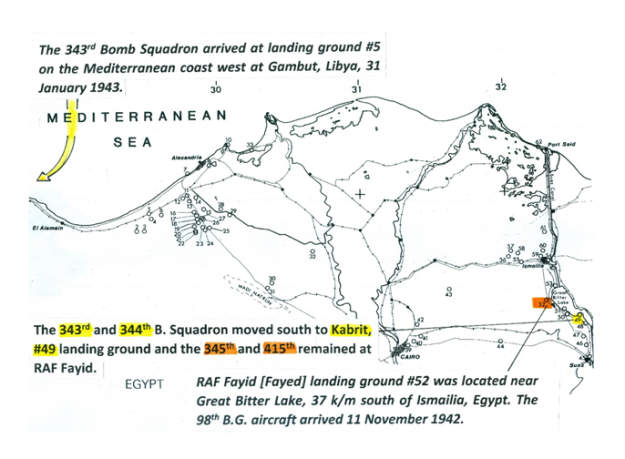
In the last week of January 1943, the four squadrons of the 98th Bomb Group began movement west from Egypt to RAF bases in the Libyan desert. The 345th Squadron arrived at Tobruk, landing ground Gubbi West on 25 January. The 415th B. S. followed, arriving Tobruk, landing ground Gubbi East on 25 January. The 343rd B. S. arrived at landing ground Gambut, Libya, on the last day of January. The 344th B.S. remained at RAF Kabrit until 3 March 1943, then flew to landing ground Lete, just east of Benghazi, Libya, on 4 March 1943. The 98th Bomb Group Headquarters moved to landing ground Benina, Libya, on 9 February 1943, and her two squadrons 345th and 415th were based 436 k/m east at Tobruk, Libya.
The Egypt-Libya Desert Campaign was one of the smaller, less well known U.S. Army Air Force battles in WWII. This campaign made a major contribution of the first Anglo-American cooperation for the later, and much larger combined endeavors in the European conflict.

In April 1943, LIFE magazine dispatched reporters to Benghazi, Libya, and six full pages appeared in the 17 May 1943 issue, eleven on the Ninth Air Force.

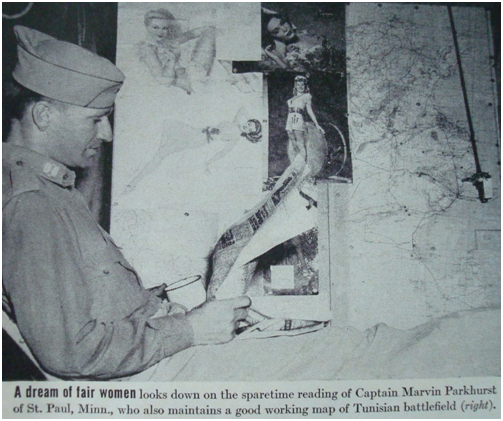


This young woman on the plane of Lieut. Jack K. Wood of Wichita Falls, Texas, has seen a lot of action in Tunisia. Name “The Vulgar Virgin” was picked by squadron vote. LIFE magazine.
This Petty Girl nude gatefold appeared in the November 1941 issue of Esquire magazine, the same week George Petty’s wife [Jule] and daughter [Marjorie] the living Petty Girl, were steaming toward Hawaii for a deserved five-week holiday. Their ship “Lurline” sailed for San Francisco on Friday, 5 December 1941, and two days later the captain called all passengers to the salon and informed them Pearl Harbor had been bombed. The two Petty Girl’s were going to war.

In October 1940, artist Alberto Vargas was signed to a three-year contract by Esquire magazine and slowly George Petty learned he would be sharing the spotlight in the magazine beginning January 1941. This complete history can be read on many websites and the excellent book “Petty” by Reid Stewart Austin. The Esquire paintings by Petty in 1941 are considered to be some of his best in both grace and nudity, direct artist competition can cause that. Above is the last Petty gatefold to appear in Esquire, December 1941, and now Alberto Vargas [Varga Girl, the “s” was dropped] would take over. A generation of American and Canadian males had grown up with the Petty Girl pin-up on their walls and now the acceptance of these early gatefolds allowed her to coast through the war years. Thousands of RAF pilots trained in Canada, and were exposed to the Petty Girl, combined with RCAF aircrew who accepted the Petty painted girls in the mid-1930s, then took her to war. Many of these 1937 to 1940 calendar Petty Girls in fact first appeared in North Africa on British RAF aircraft flown by Allied pilots.

[author collection]


[author collection]
This North African B-24D carried the title “Cielito Lindo” a most famous 1882 Mexican song which is translated into Pretty Little Sky. The full nude on a swing came from the September 1941 Petty Girl gatefold in Esquire magazine, appearing as nose art on many American aircraft.
In the Middle East a handful of British permanent aerodromes had been developed and constructed between the two world wars. However, the majority of combat missions flown in North Africa during WW II were conducted from temporary Landing Grounds, and the RAF numbered over five-hundred such locations. As soon as the Axis forces had been defeated in North Africa, these temporary Landing Grounds were abandoned and quickly reclaimed by the desert sands. The RAF now concentrated on a chain of selected landing grounds along the coast, and these were slowly improved with the erection of permanent buldings and paved runways. Many of these bases had been first occupied by the Italians, Germans, and British forces a number of times. Bengasi, Libya, was captured from Rommel by the British on Christmas Day 1941, then a month later the Germans recaptured it and held it until November 1942, when Mongomery again permanently kicked the German Army out, supported by 98th B.G. air power. Bengashi was home to three major RAF landing grounds, L.G. Benina, which was located 21 k/m east of Benghazi, and L.G. Benina [North] located next door just 1.5 k/m away. The third L.G. was Lete, located 5 k/m west of Benina, constructed by both Germans and British. On 9 February 1943, 98th B.G. Headquarters moved to L.G. Benina, Libya, with the 343rd B.S. and 344th B.S. moving to L.G. Lete on 3 and 4 March 1943. This was during the middle of the Tunisia campaign when the Allies were fighting to take Tunis and Bizert, before the Germans could send reinforcements to Tunisia. In late-July 1943, photographer and author Ivan Dmitri flew into Benghazi, Libya, and recorded the history of the Ninth Air Force in action color, appearing in his book Flight to Everywhere, published 1944.

Rommel’s Rubbish. All that’s left of a Nazi plane rots in the desert while in the background a Ninth Air Force B-24D starts on a new mission.

 The Other Fight – Dust storms. B-24D-85-CO, serial 42-40657, 376th B.G. became “GI Ginnie.”
The Other Fight – Dust storms. B-24D-85-CO, serial 42-40657, 376th B.G. became “GI Ginnie.”

The 376th [Heavy] Bomb Group was activated at Lydda, Palestine on 31 October 1942, and began B-24D operations immediately. Their unofficial badge was created during combat at Abu Sueir, Egypt, featuring a stylized yellow winged sphinx, on red sand, with a yellow 500 lb. bomb pointed downward from a dark blue sky, with motto – LIBERANDOS. Their four squadrons in 1942-45 were 512th, 513th, 514th and 515th B.S. [This WWII badge was not officially approved until 8 November 1951, while equipped with B-29s in SAC] Aircraft #100 B-24D-85-CO, serial 42-40664, was named Teggie Anne and became the Command Aircraft on the Ploesti raid 1 August 1943. They flew out of Gambut, 1 Jan. 1943, Soluch, 22 Feb. and arrived at Bengasi, Libya, on 6 April 1943, where this image was taken three months later. The bomber nose art name “Teggie Anne” was only painted on the port side.

Twilight on the desert. B-24D Liberators from the 376th B.G. dispersed for miles along the Libyan coast, comprise the fighting strength of IX Bomber Command. B-24D #41 was assigned to the 513th Bomb Squadron, wearing the official approved emblem, a gold stylized falcon riding a 500 lb. light brown aerial bomb, over a black diamond with yellow trim. They arrived at Bengasi, Libya, on 6 April 1943.

In Rommel’s Seat. General Ent, center, occupies seat in War Room where Rommel worked.
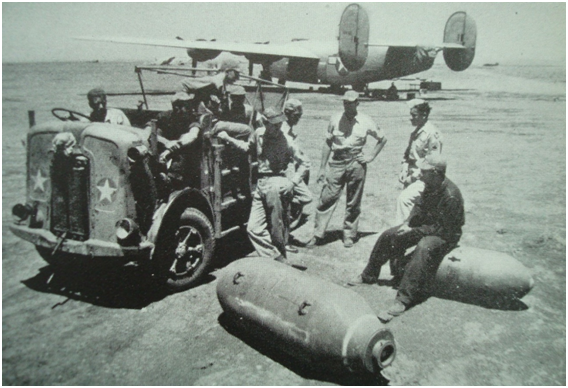
Captured Italian truck with four-wheel drive put to good use by Ninth Air Force.

Those letters from home. A real floor in the tent, a bomb-fin casing for a table. What more could any American airmen ask?

New arrivals prepare for life of war, sand, and scorpions, setting up tent.

Mess kits and cooking utensils must be rinsed in boiling water to keep tropical germs at bay.


B-24D serial 41-23661, 98th B.G., 345th Bomb Squadron, Black Jack, “Roll them bombs.”

Beneath a 1000-pounder, crew member dusts sand from ammo to prevent possible fouling.
The Ninth Air Force flew their last mission to Rome on 19 July 1943, and the following day began intensive training on the desert east of Benghazi, Libya.

This was the target practice area where the outlines of Ploesti targets were traced in the desert sand.


Some of the Ninth Air Force nose art was recorded in color – “Homesick Susie” 42-40409, “Little Joe” serial 41-24195, 98th B. G. 415th B. Squadron, “Ubangi Webangi” serial unknown and “The Little Gramper” serial 42-40722, painted by nose artist Staff/Sgt. Charles Cavage. They all went to Ploesti on 1 August 1943.


The B-24D “Ubangi Webangi” had a sister ship named “Ubangi Bag” serial 41-24194, “B” with the same nose art painted on both sides, 415th Bomb Squadron. Nose artist S/Sgt. Cecil Lippard.
On 1 August 1943, 178 Consolidated B-24 Liberator bombers took off on a 2,700-mile round trip to bomb Ploesti, Romania. One-hundred and sixty-four bombers reached the target, and fifty-four did not return. Forty-one were lost to enemy action and fourteen to other causes, including eight interned in Turkey. A total of 1,725 airmen took part in this mission and 540 were lost in the skies over Ploesti, 310 killed in action. The tragedy of Ploesti has been published in hundreds of books and websites, measured only in the American airmen’s courage with no decisive combat results, or drop in German WWII oil supply.

The 389th Bomb Group [Heavy] “The Sky Scorpions” was activated on 24 December 1942, trained for overseas duty in the B-24 bomber, and arrived at Hethel, England, 11 June 1943. Almost immediately the 389th was loaned to the Ninth Air Force in North Africa, where they arrived at Bengashi, Libya, 3 July 1943, and prepared for the raid on Ploesti, Romania. This image was taken just before take-off, showing the nose art on “Wolf-Waggin,” [name recorded by Ivan Dmitri in 1943], B-24D-95-CO, serial 42-40775. She survived the trip to Ploesti and returned to temporarily combat in Tunisia on 25 August 1943, returning to England in October 1943.
The 389th B.G. had the least losses of all the Ploesti attacking groups, only six B-24s were lost from twenty-six attacking bombers.


At dawn [06:00 hrs] on Sunday, 1 August 1943, the first of 178 Liberators “Wingo-Wango” took off for the three-hour flight across the Mediterranean towards Ploesti.

Unknown B-24D pilot concentrates on flight to Ploesti, Romania.

The 98th Bomb Group [Pyramiders] were led by a tough, professional pilot from Texas, Colonel John R. Kane, [center] who carried the nickname “Killer.” This image [with his crew] was somewhat misleading as iron man Kane was never loved by his men, and was described as never fitting the image of today’s ‘officer and gentleman.’ Cold and ruthless, he was just as courageous, an amazing war leader of the Ninth Air Force in North Africa 1943. Kane crashed Hail Columbia “V” 41-11825 at RAF Station Nicosia, Cyprus. [below 2 Aug. 43]


The 1 August 1943, 98th B. G. flight crews which attacked Ploesti oil refineries, lead by [yellow marked] 344th B.S. Col. Kane in 41-11825 aircraft “V” Hail Columbia. B-24D #9, Nespor 41-11768, “D” Kickapoo, turned back and crashed, Gaston 41-11656, “H” Rowdy II, turned back, #2, Arens 41-11803 “E” Rosie Wreck’em, turned back, and #10 Edwards, 41-11040 “F” Big Operator, turned back. Circles B-24D #7 Hinch 41-24197 “A” Tagalong, and #6 Neeley 41-11819 “G” Raunchy, were both shot down over target. Four survived [#1 Kane 41-11825 “V”, #2 Hadley 41-24311 “L”, Hadley’s Harem, #5 Banks 41-40208 “K”, Sad Sack, and #8 LeBrecht 41-11761 “I”, The Squaw, only four out of the first nine aircraft, returned to land at RAF Station Nicosia, Cyprus.

Section “E” was a mix of squadron aircraft, two turned back, six attacked the target and only Lt. Weisler in a B-24D #026 “B” named “Baby” survived, landing at RAF Nicosia, Cyprus. “The Vulgar Virgin” never came out of the target smoke and flames, missing in action.
The five groups of B-24s aircraft took off 30 seconds apart, with the 98th Bomb Group [Sections A to E] in the third assigned group. The first 98th B.G. B-24D to become airborne at 07:09 hrs were 344th Bomb Squadron serial 41-24198, “The Vulgar Virgin” piloted by Capt. Wallace C. Taylor. [Missing in Action]

Lt. Weisler, B-24D serial 41-24026, named “Baby” followed at 07:10 hrs. [landed Cyprus]
Lt. Colchagoff, B-24D serial 41-11733, “Skipper” time 07:11 hrs. [Turn back – gas tank leak]
Col. Kane, B-24D serial 41-11825, “Hail Columbia” time 07:14 hrs. [landed Cyprus]
Lt. Arens, B-24D serial 41-11803, “Rosie Wreck’em” time 07:15 hrs. [Turn back – landed Malta]
Lt. Hadley, B-24D serial 41-24311, “Hadley’s Harm” time 07:16 hrs. [landed Cyprus]
Lt. Gaston, B-24D serial 41-11656, “Rowdy II” time 07:18 hrs. [Turned back – gas tank leak]
Lt. Banks, B-24D serial 41-24208, “Sad Sack”time 07:19 hrs. [landed Cyprus]
Lt. Neeley, B-24D serial 4-11819, “Raunchy” time 07:20 hrs. [Missing in Action]
Lt. Hinch, B-24D serial 41-24197, “Tagalong” time 07:21 hrs. [Missing in Action]
Lt. Le Brecht, B-24D serial 41-23795 “Sneezy” time 07:22 hrs. [landed Cyprus]
Lt. Nespor, B-24D serial 41-11768, “Kickapoo” time 07:23 hrs. [crash landing] Just after becoming air-borne 1st. Lt. Robert Nespor lost an engine with flames shooting out. Nespor turned around and headed back to base which was still obscured with clouds of red desert sand caused by all the bombers taking-off. Kickapoo landed, roughly bounced a couple of times, then over-shot striking a concrete telephone pole at the end of the runway.


Only navigator Polivka [left] and gunner Garner escaped the burning B-24D bomber.
Lt. Edwards, B-24D serial 41-24040, “What’s Cooking Doc” [Big Operator] time 07:24 hrs. [Turn back – #3 super-Charger out] The last B-24D in the 344th B. Squadron to take-off, then turned back, touching down at landing ground Lete, Libya, at 14:55 hrs.

Internet B-24 nose art collection
Killer Kane’s Pyramiders lifted off with forty-eight B-24D aircraft, in minutes “Kickapoo” crash landed, six others turned back, and now forty-one joined the others and headed for Ploesti. 165 of the original 178 Ninth Air Force aircraft hugged the sea for the first three-hour leg of the journey. The Pindus Mountains necessitated a climb to fourteen thousand feet where the next image was taken by photographer Ivan Dmitri.

With Col. Kane at the controls “Hail Columbia” entered the smoke and flame inferno, forty bombers followed, only twenty-three of the 98th Bomb Group B-24D bombers came out of the target area smoke. Eighteen bombers were shot down, one-hundred and eighty men killed or POWs. The cost to the Ninth Air Force for 30 minutes’ work was, indeed, too high, 54 bombers lost. Of the 164 Liberators which struck the target, 41 were lost to enemy action. Only 88 B-24D bombers returned to land at Benghazi, and barely half were still flyable. Fifty-five had been heavily damaged. Two hundred and sixteen American bodies were recovered with one-hundred and eighty-six captured.
LIFE magazine reported the raid on 30 August 1943, very brief in content.


Photos taken on 2 August 1943 by Ivan Dmitri recording the extent of damage.





B-24D serial 41-11766, “Chug-A-Lug” took six direct flak hits, instantly killing the engineer/gunner, but she made it home.

“Daisy Mae” serial 41-11815, had her tail shot-up, Sgt. Lewis M. Shields and T/Sgt. Chas J. Cammock repair the tail turret. Tail gunner Sgt. Nick Hunt from Las Animas, Colo. survived this 20 mm explosive shell.
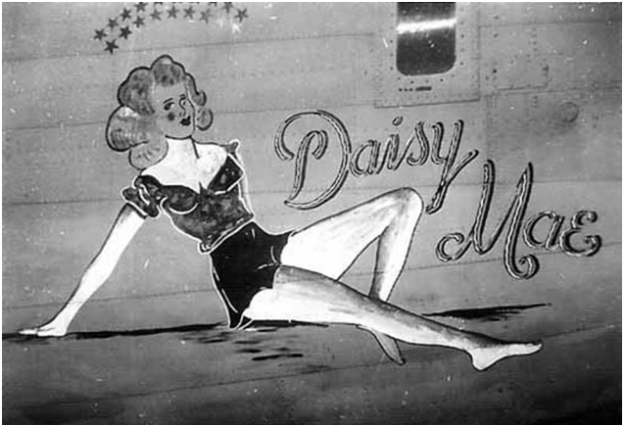

Close-up of tail fin damage to “Daisy Mae” [nose art from internet] which somehow made it home to Lete, Libya.

This B-24D was in the 93rd B. G. called “Lucky” and the Panda Bear insignia was approved for the 409th B. Squadron on 16 February 1943. The Panda lived up to the bomber name, as the Ploesti flak hole [repaired and painted over] just missed the little running bear.


The B-24D repairs on 55 aircraft took weeks as some bombers had major flak damage.
In the fifty-five B-24s which returned to Bengasi, 54 aircrew members were wounded.


In September 1943, Jack Benny and his USO troop show landed at Bengasi and the special guests were housed in the officer’s mess, with fully topless pin-up wall art. Movie star Anna Lee talks with the Ninth Air Force officers, while her ‘look-a-like’ smiles from the wall.

These original buildings had been headquarters for the “Desert Fox” Rommel.

Blues singer Wini Shaw confers with Col. Nero [middle] and Col. Compton making plans for the evening outdoor show.

Jack Benny and Wini Shaw with the Ninth Air Force members after the evening open-air performance. Note the Corporal on Wini’s right who has turned away from the camera, possibly not wanting his wife back in the U. S. to see what is going on in North Africa.

Jack Benny has a B-24D named after him, serial 41-24112.

Jack Benny USO performer “Birdie Dean” becomes a living Ninth Air Force bomber pin-up girl. The Naples-Foggia campaign began on 18 August 1943, and continued until 21 January 1944. New B-24 bombers were arriving for the Ninth Air Force, joining Allied bombardment of communications and airfields in Italy. After the invasions of Sicily and Italy, the Ninth Air Force was ordered to England 3 October 1942. They would now become the tactical air force for the invasion of the Continent. Some of these new Libya painted B-24D desert nose art gals would become famous later in England, such as “Sack-Time Sally” of the 389th Bomb Group, 565th B. Squadron. This B-24D-95-CO serial 42-40749 took part in the 1 August raid on Ploesti, [without any nose art] and flew out of Bengasi from 3 July to 27 August 1943. The nose art nude was painted in early September possibly by ground crew artist S/Sgt. Cecil O. Lippard, taken from the September issue of Esquire “Varga” pin-up girl. Vargas [dropped the ‘s’] and took over from George Petty in January 1942 issue of Esquire.

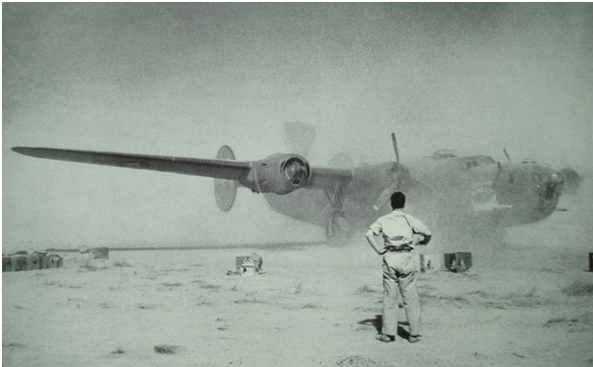
The 565th began operations from Massicault, Tunisia, 20 September 1943, so that dates this image first two weeks in September at Bengasi, Libya.

American Air Museum Britain UPL15278
“Sally” flew from Hethel, England, and was shot down over Holland, on 26 November 1943. More detailed history can be found on the American Air Museum Britain website.

During the summer of 1943, two veteran B-24D bombers which survived the air war in North Africa, were sent home for American War Bond tours. This presented a major nose art nudity problem for the folks back home in the United States.

A most famous Ploesti survivor B-24D-20-CO, 41-117671, 98th Bomb Group, 343rd B. Squadron, with original painted nose art recorded on 16 mm film in July 1943, at Libya.

This little native nude flew with “The Vulgar Virgin” part of the infamous Ploesti raid on 1 August 1943, and survived seventy-three missions in North Africa. However, you could never show this to the American public [even in today’s museum’s 2020] so, the original nose art was [censored] repainted for her war bond tour.

This is the “fake” 1943 nose art painted on B-24D-2-CO, serial 41-11761, “The Squaw.” The full history can be found on a number of websites, but thanks to the internet, plus many professional model builders, the true history can now be told and shown in B-24D decals.

The true tragedy of what actually took place over Ploesti on 1 August 1943 would not be fully understood until postwar interviews were conducted with 186 American P.O.W. airmen.

The Bomb Group’s mix-up and military nightmare which took place afterwards has been recorded many, many, times and need not be repeated in detail here. The leading group to attack Ploesti were the 376th B.G. [twenty-nine B-24D] followed by the 93rd B.G. with thirty-nine bombers. These two groups made a turn too early, mistaking Targoviste for the [Initial Point] at Floresti, twenty miles further north/east. This pointed the two groups towards Bucharest, becoming the most fatal incident of the entire mission. The 389th B.G. [twenty-six B-24D] left the other four groups at the city of Pitest, [Initial Point] and at five hundred feet struck their targets at Campina. The 98th B.G. [forty-one B-24D] and 44th B.G. [thirty-six] bombers followed the correct flight plan, taking them directly over a heavily armed German flak train “Die Raupe” [caterpillar] on the main line from Floresti to Ploesti, which damaged several Liberators, shooting down seven B-24Ds in Killer Kane’s 98th Bomb Group. This German flak train [camouflaged as freight train] with a full head of steam, literally chased the two Bomb Groups towards Ploesti.
Col. Kane at the controls of “Hail Columbia” led thirty-four B-24s [the German flak train shot down seven bombers] of the 98th B.G. into the intense heat and flame of the target area, but only nineteen escaped the inferno and intense flak, twenty-two were shot down.
B-24D-20-CO “The Vulgar Virgin” led the last “E” Section of six bombers [two turned back] into the target and only Lt. Weisler in “B” serial #026 came out of the smoke and flame. Five B-24D aircraft were shot down.


The only survivor from B-24D, serial 41-24198 “The Vulgar Virgin” was the pilot Capt. Wallace C. Taylor. On 15 October 1945, Major [promoted postwar] #0-729382 Wallace Taylor was interrogated by 1St. Lt. Lucille Caldwell and the following was stated:
The Vulgar Virgin was flying as lead aircraft in “E” section of the 98th Bomb Group attacking formation. Over the target the bomber took a direct flak hit in the nose section and burst into flames. Capt. Taylor pulled out of the formation –
“I immediately called the nose and tail but could not contact either one. I then gave the bail out order and rang the alarm bell. I saw the co-pilot, engineer, and assistant engineer bail out. I do not know what happened to the other members of the crew. I bailed out and landed in the vicinity of Ploesti. I left the plane when those with me were out and it was impossible to stay longer in the flames and heat.”

F/O Paul W. Packer, Co-pilot [KIA], 1st Lt. Jack K. Wood, Navigator [KIA], 1st. Lt. Robert N. Austin, Bombardier [KIA], T/Sgt. Gerald E. Rabb, Engineer/top gunner, [KIA], T/Sgt. Alfred F. Turgeon, Radio Operator/left waist gunner [KIA], S/Sgt. Ralph M. Robbins, Gunner/asst. engineer [KIA], S/St. Louis Kaiser, Right waist gunner [KIA], S/Sgt. Donald H. Duchene, Tail gunner [KIA], Sgt. Arthur B. Van Kleek, Tunnel gunner, [KIA].
More than eighty brave American flyers who perished on that “Black Sunday” remain unrecovered.


This 31” by 31” replica nose art painting was completed by the author on original B-25 WWII U.S. Navy aircraft skin, the green paint is original American wartime color. This is from a special private collection of Mr. Nose Art, Clarence Simonsen, and at age 76 years, the artist has decided to give his little nude “Petty Girl” a new home. She is for sale, but must have a good setting, and please keep her warm. This was painted in honour of the aircrew of “The Vulgar Virgin.” The November 1941, Esquire gatefold pin-up [below] is also included.

“Oh, General, I bet you tell that to all the spies!”




